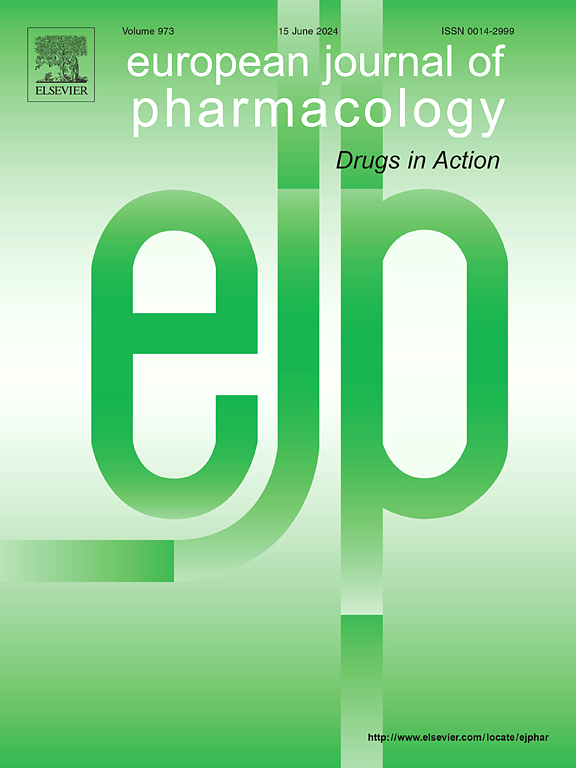Silymarin nanoparticles counteract cognitive impairment induced by doxorubicin and cyclophosphamide in rats; Insights into mitochondrial dysfunction and Nrf-2/HO-1 axis
IF 4.2
3区 医学
Q1 PHARMACOLOGY & PHARMACY
引用次数: 0
Abstract
Most cancer patients suffer cognitive impairment following chemotherapy, recognized as “chemobrain”. Principally, doxorubicin and cyclophosphamide are frequently utilized conjointly for the treatment of several kinds of tumors. Silymarin was reported to possess anti-inflammatory, antioxidant, and neuroprotective impacts. The recent study shed light on the neuroprotective attributes of silymarin against cognitive dysfunction instigated in rats with doxorubicin/cyclophosphamide combination. Unfortunately, silymarin suffers reduced absorption following oral administration. Silymarin was formulated as a nanoemulsion to be administered intranasally. Male rats were allocated into six groups: control, doxorubicin (2 mg/kg, ip) and cyclophosphamide (50 mg/kg, ip), doxorubicin and cyclophosphamide + silymarin (200 mg/kg, oral), doxorubicin and cyclophosphamide + silymarin nanoemulsion (1 mg/kg, intranasal), silymarin (200 mg/kg, oral), and silymarin nanoemulsion (1 mg/kg, intranasal) groups, and treated for 21 days. The amount of silymarin reaching the brain was found to be enhanced following formulated nanoemulsion administration. Doxorubicin and cyclophosphamide caused behavioral, as well as memory deficits indicated by locomotor activity, y maze, and passive avoidance tests. Also, they induced histological alteration in hippocampi and the prefrontal cortices of rats. Besides, chemotherapy caused cognitive impairment assessed by acetylcholinesterase activity elevation. Additionally, caspase-3 augmentation and of nuclear factor erythroid 2-related factor-2 (Nrf-2) and heme oxygenase-1 (HO-1) pathway disturbance were found following chemotherapy treatment. Silymarin treatment opposed such effects via enhancing memory function, preserving brain architecture, and reducing acetylcholinesterase activity and caspase-3 level. Moreover, silymarin treatment improved mitochondrial biogenesis through activation Nrf-2/HO-1 axis. Collectively, silymarin nanoemulsion, at a 200-fold lower dose, can offer an innovative solution for cancer patients globally.

水飞蓟素纳米颗粒对阿霉素和环磷酰胺致大鼠认知功能损伤的影响线粒体功能障碍与Nrf2/HO-1轴的关系。
大多数癌症患者在化疗后出现认知障碍,被称为“化疗脑”。原则上,阿霉素和环磷酰胺经常联合用于几种肿瘤的治疗。据报道水飞蓟素具有抗炎、抗氧化和神经保护作用。最近的研究揭示了水飞蓟素对阿霉素/环磷酰胺联合用药引起的大鼠认知功能障碍的神经保护作用。不幸的是,水飞蓟素在口服后吸收减少。水飞蓟素配制成纳米乳剂,经鼻给药。将雄性大鼠分为对照组、阿霉素(2 mg/kg,口服)和环磷酰胺(50 mg/kg,口服)、阿霉素和环磷酰胺+水飞蓟素(200 mg/kg,口服)、阿霉素和环磷酰胺+水飞蓟素纳米乳(1mg/kg,鼻内)、水飞蓟素(200 mg/kg,口服)和水飞蓟素纳米乳(1mg/kg,鼻内)6组,治疗21 d。水飞蓟素到达大脑的量被发现在配方纳米乳管理后被增强。多柔比星和环磷酰胺引起运动活动、y迷宫和被动回避测试显示的行为和记忆缺陷。此外,它们还诱导了大鼠海马和前额叶皮层的组织学改变。此外,化疗引起的认知障碍通过乙酰胆碱酯酶活性升高来评估。化疗后caspase-3升高,核因子-2相关因子-2 (Nrf-2)和血红素加氧酶-1 (HO-1)通路紊乱。水飞蓟素通过增强记忆功能、保持大脑结构、降低乙酰胆碱酯酶活性和caspase-3水平来对抗这种影响。此外,水飞蓟素处理通过激活Nrf2/HO-1轴促进线粒体生物发生。总的来说,水飞蓟素纳米乳的剂量降低了200倍,可以为全球癌症患者提供一种创新的解决方案。
本文章由计算机程序翻译,如有差异,请以英文原文为准。
求助全文
约1分钟内获得全文
求助全文
来源期刊
CiteScore
9.00
自引率
0.00%
发文量
572
审稿时长
34 days
期刊介绍:
The European Journal of Pharmacology publishes research papers covering all aspects of experimental pharmacology with focus on the mechanism of action of structurally identified compounds affecting biological systems.
The scope includes:
Behavioural pharmacology
Neuropharmacology and analgesia
Cardiovascular pharmacology
Pulmonary, gastrointestinal and urogenital pharmacology
Endocrine pharmacology
Immunopharmacology and inflammation
Molecular and cellular pharmacology
Regenerative pharmacology
Biologicals and biotherapeutics
Translational pharmacology
Nutriceutical pharmacology.

 求助内容:
求助内容: 应助结果提醒方式:
应助结果提醒方式:


